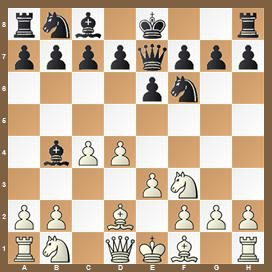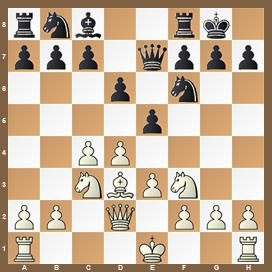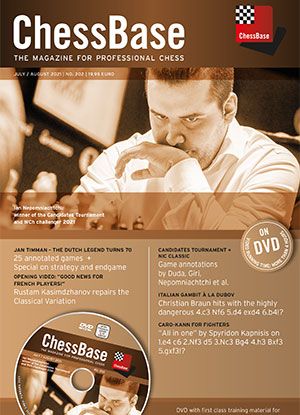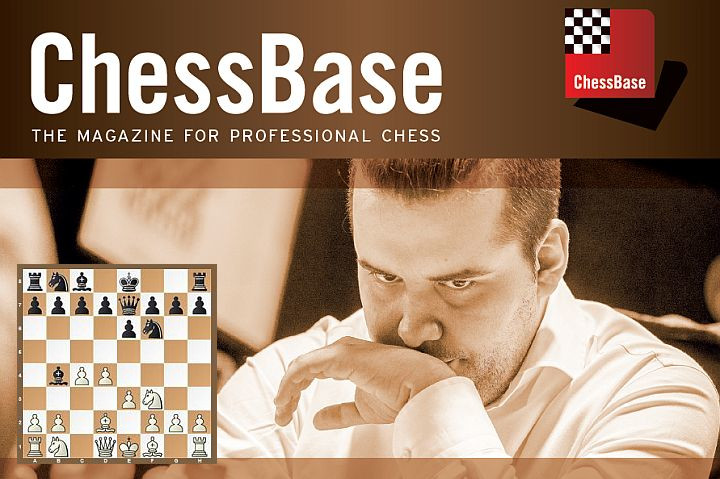A new way against the Bogo-Indian
Lars Schandorff looks at 4.Bd2 Qe7 5.e3!?
The Bogo-Indian 1.d4 Nf6 2.c4 e6 3.Nf3 Bb4+ 4.Bd2 Qe7 remains a popular opening for Black, at least at club level - probably due to the fact that it is easy to learn and quite solid and still rather deep strategically speaking. In nearly all games White almost automatically responds with 5.g3. This is a good move, of course, and White has reasonable chances to come out of the opening with a small plus, but 5.g3 is also the move Black expects and is prepared to face. White has an interesting alternative that quickly leads to much less explored positions full of new possibilities for both sides. I am talking about the move 5.e3!? recommended by the American grandmaster Sam Shankland.

White plans to put the bishop on d3 and then castle. Black has two standard Bogo-Indian set-ups he can choose from: ...b6 and ...Bb7 or ...d6 and ...e5. Other moves like an early ...d7-d5 leads to a pawn structure well known from the Queen´s Gambit Declined which in the Bogo-version is generally more pleasant for White although Black is of course very solid. Still, in this survey I concentrate on the two major plans.
1) Black plays ...b6
If Black wants to play ...b6 and ...Bb7 he might as well start with 5...b6. I will return to that in a minute, but let´s first have a look at the most common move order: 5...0-0 6.Bd3 b6 7.Nc3 Bb7 8.0-0.

This position can also arise from the Nimzo-Indian. It is very illustrative of what White is striving for: he wants to force Black to take on c3 and then enjoy his pair of bishops. It doesn´t seem like much because Black then has good control over the important e4-square, however, slowly but surely White will expand and try to open up the position for his bishops. These middlegames are crucial to understand if you want to be a successful 1.d4 player - and who wouldn´t! Play can go in different directions, here are three examples:
8...d6 Flexible and the most natural 9.Qe2 Bxc3 10.Bxc3 Ne4 11.Be1! White keeps the bishops and has a small but stable advantage, Rychagov,A - Postny,E 1-0.
8...a5 A typical Bogo-Indian move 9.a3 Bxc3 10.Bxc3 Ne4 11.Be1! Again this important resource securing the better chances, Shankland,S - Saric,I 1-0.
8...d5 This is probably more likely to come from the Nimzo-Indian as our illustrative game in fact does. Bogo-Indian players usually go for more flexible setups, but theoretically this d5 move is of course important. White answers 9.cxd5 exd5 10.Ne5 and we have transposed to Sadler,M - Lau,R 1-0.
Like I mentioned Black could consider 5...b6. After 6.Bd3 Bb7 7.0-0 Bxd2! 8.Nbxd2

Black has solved the problem with his bishop on b4 and is very solid. Still, White has the more pleasant position mainly due to his extra space. Typically White will expand in the centre with e4 and maybe d5, see Shalimov,V - Kovalchuk,V 1-0.
2) Black plays ...d6
A popular plan for Black is to go for direct counterplay in the centre with ...d6 and ...e5. Play goes like 5...0-0 6.Bd3 Bxd2+ 7.Qxd2 d6 8.Nc3 e5.

This is the basic position. Of course other moves were possible along the way, for instance White could have taken on d2 with his knight like in the above example. I prefer taking with the queen, because the knight will be much stronger on c3 than on the passive d2-square. A further benefit of having the queen on d2 is that White can speculate in castling long. The key move for White to keep the variation alive is 9.Bc2! It has only been played in a few games and Black has won the majority of them! But if you look a little closer you can see a lot of potential in White´s position.
9...e4? This was the threat that 9.Bc2! specifically is designed to prevent! After 10.Ng5! Black is in trouble because 10...Bf5 is met by 11.f3!.
9...Bg4 Sound and active development. However, White can use the fact that he has not castled yet and immediately pose a question to the black bishop: 10.h3! Bxf3 11.gxf3 planning 0-0-0, see Kecic,S - Krumpacnik,D 0-1.
9...Nc6 The most solid, but White seems to be slightly preferable, see Leukhin,A - Abramov,I 0-1.
Conclusion: The move 5.e3 is a good alternative to the more common 5.g3. It is hard to believe it is better, but I hope that this survey has proven that White has good chances to fight for an advantage or at least a somewhat more pleasant position. The great thing about 5.e3 is of course that it leads to more original positions where a little preparation combined with good play might put a lot of pressure on your opponent right from the start. Anyway, I think it is worth a try!
You can find the full atricle with all games and analyses in the new ChessBase Magazine #202!

Single isssue: 19,95 € – annual subscription (6 issues) 99,70 €
Available for download (including booklet in pdf) or on DVD + booklet (Post).
Test ChessBase Magazine now and win twice!
Take your chance and train with the experts from ChessBase Magazine. Take your chess to a new level with the help of many renowned authors!
All subscription offers and further information can be found on the ChessBase Magazine homepage.




























